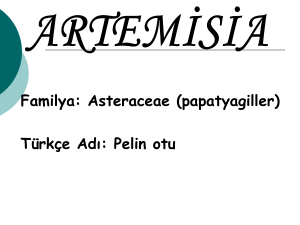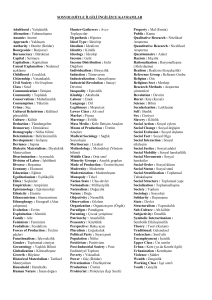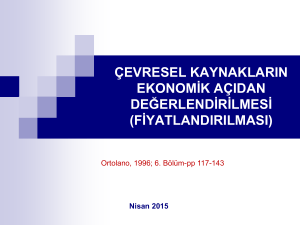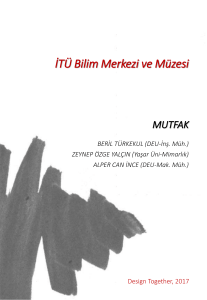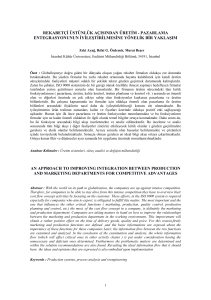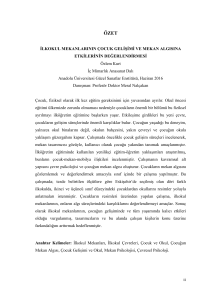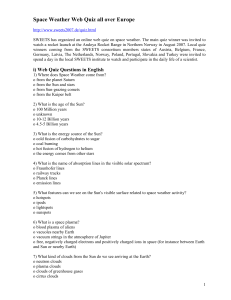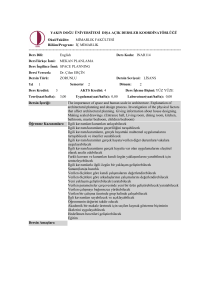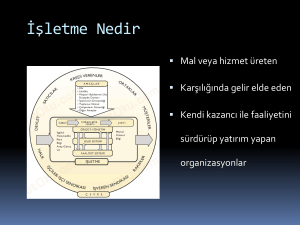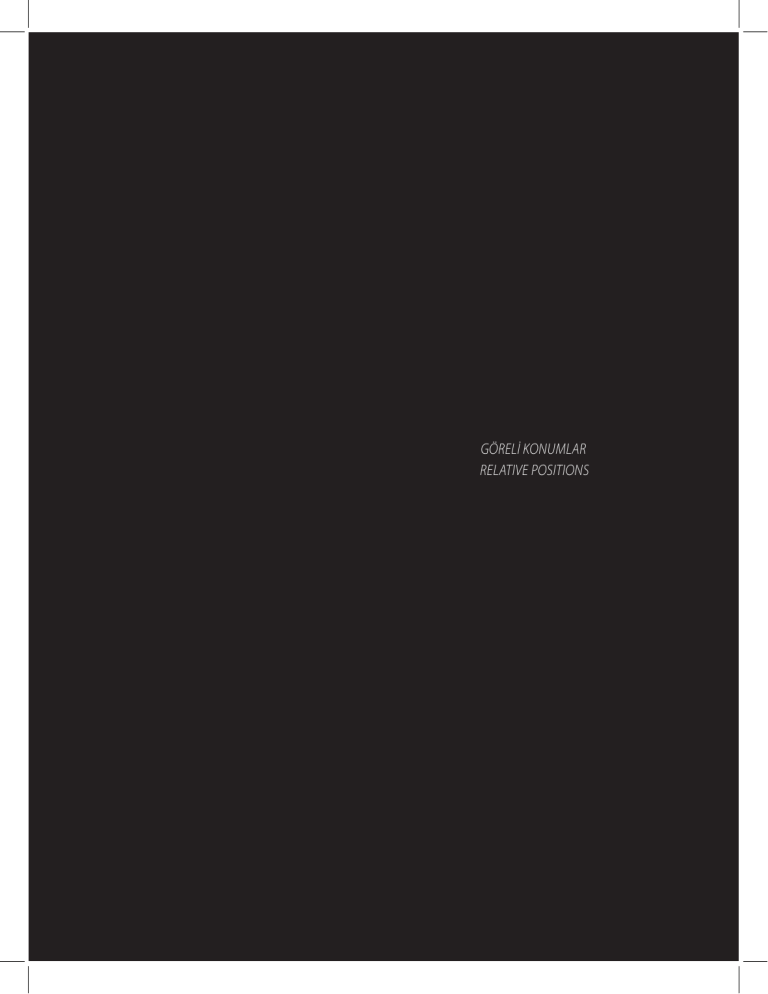
GÖRELİ KONUMLAR
RELATIVE POSITIONS
3
Göreli Konumlar / Relative Positions
Ekim / October 2011
İstanbul, Türkiye / Turkey
Katkıda Bulunanlar / Contributors
Editör / Editor
Önder Özengi
Yazarlar / Authors
Ahmet Öğüt / Ashkan Sepahvand / Borga Kantürk
Boris Buden / Brian Holmes / Burak Arıkan
Caner Aslan / Deniz Gül / November Paynter
Önder Özengi / Pelin Tan / Ulus Atayurt
Sanatçılar / With Works by
Borga Kantürk / İnci Furni / Kanalkayıt (Can Altay, Başak Akçakaya,
Emrah Kavlak, Taylan Hacırüstemoğlu, Deniz Erdem, Çağrı Küçüksayraç,
Pelin Göre, Gülşah Taşkın, Sevgi Aka, Nesli Yağlı, Kaan Birol)
Merve Şendil / Pelin Tan / Vahit Tuna
Çeviriler / Translations
Duygu Dölek
Erden Kosova
Nazım Hikmet Dikbaş
M. Emir Uslu
Pınar Üner
Tasarım / Graphic Design
Caner Aslan
Fotograflar / Photographs
Sıtkı Kösemen
Vahit Tuna
Düzelti / Proofreading
Ahu Özden
Duygu Dölek
Erden Kosova
William Buchina
Teşekkürler / Thanks
Gerald Raunig, eipcp - European Institute for Progressive Cultural Policies
Bu kitap, 16–30 Nisan 2009 tarihleri arasında Suriye Pasajı’nda yapılan
Göreli Konumlar ve Kanaatler adlı sergiden yola çıkılarak hazırlanmıştır.
This book is based on exhibition titled Relative Positions and Conclusions
which took place at Suriye Passage in April 2009.
Yayımlanan yazıların her türlü hakkı, sorumluluğu ve tasarrufu yazarlara aittir.
All rights, responsibility and provisions belong to the authors.
ISBN: 978-605-5612-016
9
Göreli Konumlar ve Fark Üretimi
Relative Positions and the Production of Difference
17
Mekanin Özgürleşmesi Ve Özerklik Sorunu
Emancipation Of Space And The Question Of Autonomy
ÖNDER ÖZENGİ
PELİN TAN
34Alıntılar
Excerpt
ASHKAN SEPAHVAND
44
Bir Çalgı Parçası Olarak Beden
Body as a Piece of Instrument
49
Gayri Maddi Emek Üzerine Notlar
Notes on Immaterial Labour
66
Koninin İçinden
Through the Frustum
72
“-1” İzmir Güncel Sanat Arşivi
Kayda Geçmeyeni Tekrar Düşünmek, Yeni Kayıt Ve Tartışma Olanakları
“-1“ İzmir Contemporary Art Archive
Re-Thinking The Unrecorded, New Possibilities Of Recording And Argument
90
Caner Aslan ile Bir Monolog
A Monologue with Caner Aslan
92
15 Dakika
15 Minutes
105
Krizsiz Eleştiri: Eleştirisiz Kriz
Criticism Without Crisis: Crisis Without Criticism
125
Disiplin-Dışı Soruşturmalar: Kurumların Yeni Bir Eleştirisine Doğru
Extradisciplinary Investigations: Towards A New Critique Of Institutions
ULUS ATAYURT
BURAK ARIKAN - DENIZ GÜL
NOVEMBER PAYNTER
BORGA KANTÜRK
AHMET ÖĞÜT
CANER ASLAN
BORIS BUDEN
BRIAN HOLMES
6
7
8
9
GÖRELİ KONUMLAR
VE FARK ÜRETİMİ
ÖNDER ÖZENGİ
Kültürel, sınıfsal ve coğrafi kimlik, son yıllarda üzerinde daha fazla tartıştığımız,
kendimizi tanımlarken ve ortaklıklar kurarken önem atfettigimiz, konumlarımızın
ve üretimlerimizin arka planında işlettiğimiz kavramlar. Kendimizi içinde yaşağımız
dünyaya, coğrafyaya, topluma, cemaate bağlayan konum ve fark üretimleri, ilk referans noktalarını oluşturmaları yüzünden önemleri farklı derecelerde de olsa her zaman
korunur. Farklı ölçeklerdeki mekanlarda, farklı konumlanmalara zemin oluşturan bu
kavramlar, dünyayı tasavvur ederken katı ve değişmez olarak tahayyül edilen farkları
da keskinleştiriler.
“Küreselleşme” adı verilen, metaların ve emeğin dünya coğrafyasında hızla dolaşımı
ile birlikte, yine dünya üzerinde kök salmış toplumsal biraradalıklar, sosyo-ekonomik ve
siyasal süreçler tarafından yeniden üretildi, korundu, zayıflatıldı ve yeniden oluşturuldu.
Kent ölçeğinde farklılık ve konum üretimi, hakim piyasa koşulları tarafından ve onun
göreli arz/talep denklemine göre yaşam tarzı ve ortak değer toplulukları gibi biçimlerde yeniden ve yeniden üretiliyor. Eski dünyaya atfedilen, geçersizleştiği ilan edilen
sınıfsal, etnik ve siyasal ayrımlar da yerini yenilerine bıraktı. İşçi sınıfının yerini göçmene
ya da başka etnik köken grubuna bırakması gibi. Bir zamanların kimlik, kültürel ayrım
10
11
ve farkların, kent ölçeğinde geçerlilikleri tartışılır hale geldi.
Yaşadığımız coğrafyada son yıllarda bu kısırlaştırılmış ve tek bir düşünsel ölçeğe indirgenmiş üretimler üzerinden toplumsal kavrayışlar ve çatışmalar üretildiğine fazlaca
tanık olduk. İslamcı, laik, doğulu, batılı gibi bir ölçüde metalaşmış kültürel kategori ve
konumlar, var olan başka türlü fark üretimi yollarının sesini duyulmaz hale getirdi. Ve
bu bağlamda ortaya çıkan kimlik ve farklılıkları ideolojikleştirmek yoluyla belli ölçeklere
sabitledi.
Peki yine bir toplumsal ve Bourdieu’ya göre sınıfsal bir konum olan sanat ortamı?
Günümüz güncel sanat ortamı farklı konumsallıklar üretmenin yanında çoğu zaman
varolan kategorileri içselleştirdi. Ulus ya da belli bir temsil pratiklerinin retorikleri ekseninde gerçekleşen gösterilerin gönüllü tarafları olabildi.
Sanat alanı yine barındırdığı potansiyelle ve başka türlü oluşlarla girdiği yaratıcı
ilişkilerle konum ve fark üretiminin en etkili alanı oldu. Özellikle 90 sonrası gelişen iletişim araçları ve coğrafi dolaşımın göreli olarak artmasıyla sanat alanında da dışarısı
ile çoğalan karşılaşmalar, öteki alanlarla girilen ilişkiler, evrensel ve yerel olan üzerine
girişilen tartışmalar bu ortamı zenginleştirdi. Disiplinler arası ve üstü araştırmalar ve
eylemlerle yapılan flörtler hem varolan kategorilere yenilerini ekledi hem de üretim
merkezlerini demokratikleştirdi. Bundan dolayı sanat, konumların kurumsallaşmasının
ve özgürleşmesinin arasındaki çatışmanın en etkili ve en üretici cephesi görümünde.
Bunun yanında sanatın politika ile girdiği karmaşık ilişki dolayısı ile sorunsallaştırdığı
konum meselesi Ranciere’in ünlü tespitinde daha da derinleşmekle kalmadı, bu ilişkiyi
her türlü bağlanmanın ötesine taşıdı.
“Sanat, toplumsal ve siyasi meselelerle ilgili meselelerle ilgili mesajlar ve duygular
ileterek siyasi olmaz. Toplumsal yapıları, çatışmaları ya da kimlikleri yansıtma biçimi ile
de siyasi olmaz. Tam da bu işlevlere aldığı mesafe yoluyla siyasi olur. Sadece eserleri ya
da anıtları değil belirli bir mekan–zaman sensoryumunu şekillendirdiği ölçüde siyasi
olur; çünkü bu sensoyumun birlikte ve ayrı, içeride ve dışarıda önde ve arkada vs. olma
biçimlerini tanımlar. Sanat, pratiklerin, yaşam biçimlerinin hissetme konuşma tarzlarının bir duyuda (common sence), yani ortak bir sensoryum’da somutlaşan bir “ortaklık
duyusu” nda birleşme tarzını yeniden düzenleyen görünürlük formlarını biçimlendirdiği
ölçüde siyasidir.”
“Göreli konumlar ve kanaatler” adlı sergide yer alan çalışmalar, bu meseleler ve düşünceler etrafında bir araya getirildi. Katılımcıları ve pratikleri ile bu sergi, mekan üretimi, bellek, arşivleme, kolektif bilgi ve bağlam üretimi, toplumsal tahayyül ve çatışma
gibi konular üzerinden konum ve fark üretimi yollarını araştırıyor. Kontrolsüz görelilik
ve sınırsız postmodern eklektizm ile ilişkisinin barındırdığı tehlikelerin bilincinde olarak;
benzerlik ve farklılık arasındaki ilişkileri, kişinin tikelliği ile ötekinin evrenselliğini tartışmak adına.
Referanslar
David Harvey, Umut Mekânları, (Çev.Zeynep Gambetti), Metis Yayınları, 2008.
Jacques Rancière, The Politics of Aesthetics, Continuum, 2006
12
13
RELATIVE
POSITIONS AND
THE PRODUCTION
OF DIFFERENCE
ÖNDER ÖZENGİ
Cultural, class- and geographical identity and culture are concepts we have increasingly discussed and put to use in the background of out positions and production
in recent years and placed importance upon as we define ourselves and establish
partnerships. Our positions and the productions of difference which accompany them
connect us to the world, place, society and community we live in and retain their
importance at various degrees since they constitute the initial point of reference. These
concepts provide basis for different positioning at different scales and in different
locations and they also hone differences imagined to be rigid and permanent as we
conceive the world.
As globalization rapidly spread across the world, deeply-rooted social forms were
reproduced, protected or weakened, or reformed by socio-economic and political processes. On the urban scale, dominant market conditions determine the reproduction
of difference and position according to the demand/supply equation in forms such as
life-style and common-value communities. Class-, ethnic and political distinctions attributed to the old world and declared invalid have been replaced by others, in the same
manner that the working class has been replaced by the immigrants or groups from
14
different ethnic backgrounds. The validity on the urban scale of identity based cultural
distinction and differences of the past have been opened to question.
In recent years we have increasingly witnessed the production of social conceptualizations and clashes via these sterilized productions reduced to a single ideological
criterion. A number of considerably commoditized cultural categories and positions
including Islamist, secular, eastern and western, have silenced other routes for the
production of difference. Identities and differences emerging in this context have then
been rendered immovable via ideologization.
So what about the art environment which occupies a social and, according to Bourdieu, also a class position? Today’s contemporary art environment has both produced different positioning and also internalized existing categories. A section of the art
environment found in itself the will to take sides in demonstrations realized in line with
nationalist rhetoric or certain practices of representation.
On the other hand, with the potential it contained and the creative relationships it
entered into with other becomings, the field of art also became the most effective field
for the production of positions and difference. Especially with the post-90s development of communication tools and a relative increase in geographical circulation, the
environment was enriched with an increased number of meetings with the outside,
relationships entered with other fields and discussions regarding the universal and the
local. Flirtations with inter- and transdisciplinary research and actions both added
new categories to existing ones and democratized production centres.
This is how art has become the most effective and productive front for the clash
between the institutionalization and emancipation of positions. In addition to this,
the problem of positioning, problematized because of the complex relationship art has
entered with politics, was not only extended as exemplified in Rancière’s famous ascertainment, but it also rescued art of its direct engagement with politics.
“Art is not political owing to the messages and feelings that it conveys on the state
of social and political issues. Nor is it political owing to the way it represents social
structures, conflicts or identities. It is political by virtue of the very distance that it takes
with respect to those functions. It is political insofar as it frames not only works or
monuments, but also a specific space-time sensorium, as this sensorium defines ways
of being together or being apart, of being inside or outside , in front of or in the middle
15
of , etc. It is political as its own practices shape forms of visibility that reframe the way
in which practices , manners of being and modes of feeling and saying are interwoven
in a commonsense , which means a “sense of the common” embodied in a common
sensorium.”
These are the issues and thoughts around which the works in the exhibition have
been brought together. Through its participants and practices, this exhibition investigates routes of position and difference production via topics including the production
of space, memory, archiving, collective production of information and context, social
imagination and conflict. In awareness of the dangers its relationship with unrestrained relativism and unbounded postmodern eclecticism contains and in the name of
discussing the relationship between resemblance and difference, the particularity of
the individual and the universality of the other.
References
David Harvey, Spaces of Hope, Berkele, CA: University of California Press, 2000
Jacques Rancière, The Politics of Aesthetics, Continuum, 2006.
Translated by Nazım Dikbaş
16
17
MEKANIN
ÖZGÜRLEŞMESİ
VE ÖZERKLİK
SORUNU *
PELİN TAN
“Kurulmakta olan toplumun (instituting society), kurumsal toplum (institutive society) olarak yaratılması, her seferinde bir ortak dünyadır (kosmos
koinos), bireylerin, onların türlerinin, ilişkilerinin ve etkinliklerinin belirlenmesi; ama aynı zamanda nesnelerin, onların türlerinin, ilişkilerinin ve
anlamlarının belirlenmesi – bunların hepsi ortak olarak kurulmuş başvuru çerçeveleri ve kutuları içinde tutulmaktadır, böylece bir arada var olurlar. “
Cornelius Castoriadis1
Sanırım sanat “mekanının” eleştirisi için bir dayanak noktası bulmak için iki yol var:
Mekanın (fiziksel ya da kurumsal) yapısı kolektif arzunun üretimiyle yayılabilir; ya da
eleştirel uygulamaların sınırlandırıldığı ve böylece temsiliyetlerin bir arada var olabilmelerine yol açan geçici bir mekan yaratılabilir. Günümüzde, bu gibi durumlarda,
sanatçı, kendi eserini hem ontolojik bir bakış açısıyla, hem de kendini konumlandırdığı
ve ona göre hareket ettiği kültürel söylemlerle değerlendirmelidir. “Mekan”ın bu proje
dahilinde gerçek bir anlamı vardır; tam anlamıyla fiziksel bir mekandan söz edilmektedir. Bir mekanın kullanılmak üzere ve aynı zamanda tüm kurumsal çerçevelerden
özgürleşmesi amacıyla geçici olarak işgal edildiği bu sergide, bu bir odak noktasıdır.
Bir mekanı (sanatçının “tekil” olarak kaldığı) kolektif bir arzunun peşinden gitmek
amacıyla eylemler, etkinlikler ve özel bir temsiliyet türü yaratmak için işgal etmek ne
* Bu metin “Social Production in Art and the Question of Autonomy” (Pelin Tan, edit.Liam Gillick) makalesinin bir parçasından yola çıkılarak üretilmiştir.
1 Cornelius Cotariadis, The Imaginary Institution of Society, (Trans.by K.Blamey), The MIT Press Cambridge, Massachusetts
(original book 1975, Galimard, Paris)
18
19
anlama gelir? Sanatçı eseriyle güçlü bir mekansal kimliğe sahip bir mekan arasında
nasıl bir bağ kurabilir? Sanatçı Mürüvvet Türkyılmaz2 Göreli Konumlar ve Kanaatler
sergisi ziyareti esnasında yaptığı eleştiride, serginin “mekanın özgürleşmesi” konusunda
başarı sağlayamadığına değinmiştir. Mekanın özgürleşmesi mekanı şimdiki/geçmişteki
mekansal kimliğinden ve belleğinden ayırmaya çalışmak mıdır? Ya da sergide yer alan
tekil işlerin veya katılımcıların temsiliyetlerinin birlikteliğine izin verecek yeni bir mekansallık yaratacak yeni bir anlam eklemek anlamına mı gelir? Sergi mekanı, Beyoğlu
İstiklal Caddesi’ndeki Suriye Han binası içindeki Suriye Pasajı’nın dördüncü katıydı. Günümüzde Beyoğlu’nun mutenalaştırılmış kültürel tüketiminin ana merkezini oluşturan
bu bölge, aynı zamanda 6-7 Eylül gibi (1955, İstanbul’un Rum azınlıklarına karşı tertip
edilen katliam) vahşi geçmişi belleğinde barındırıyor ya da “Cumartesi Anneleri” gibi siyasi direniş ve taleplere ev sahipliği yapıyor. Buna rağmen, İstiklal Caddesi güncel sanat
kurumları ve galeriler ile kurumsallaşmakta; ortak bilgi ve kültür “normalize” olmaya
devam etmektedir. Bununla beraber, Beyoğlu’nun bölünmüş alt-kültürünün dinamik
içeriği, avangard etkinliklerin olanaklarını bir şekilde sanatsal bölge içinde tutarak eleştiri eyleminin olasılığını taşımasını sağlıyor. Bu bağlamda, Türkyılmaz’ın görüşleri, bu
sergi süresince peşinde olunması amaçlanan kurumsal eleştirinin temelini bulmak için
bu toplanmanın, bir araya gelmemenin “ortak alan”ı üzerinde tartışmaya yönelik çeşitli
konulara yöneltiyor bizi.
Temelde sosyal ilişkilerin yeniden üretimiyle geliştirilen ama aynı zamanda bir
“özerklik” arayışı içinde olan bir uygulama peşinde olmayı gerektiren bir sanat “biçimi”
bulmaya çalışmak bir ikilem içerir. Bence bu ikilemin birbiriyle ilişki içinde olan çeşitli
kavramsal katmanları vardır; bölge/sınırlar, artı-değer ve söylemsel kurum pratiği gibi.
Temelde, sergi yapısı kolektif, tutarsız bir kişiler arası üretim olarak değerlendirilmesi
gereken kısa vadeli geçici bir sergi olarak kurulmuştur. Anton Vidokle ile UNP projesi3
hakkında yaptığımız görüşmelerin birinde, travmatik ve siyasi geçmişten etkilenmiş
olan cemaat ya da bölgelere yapılan yerel müdahalelerin etiği üzerinde durmuştuk4.
Örneğin UNP-Berlin projesi, Doğu Berlin’de Lenin’in heykelinin bulunduğu meydanındaki bir süpermarketin eski deposunda, devrimin başarsızlığı bağlamından hareket eden
bir dizi seminer, performans ve tartışmadan oluşuyordu. Vidokle ile yerel alanları ideolojik bir çerçeve ve kolektif bir yöntem ile işgal eden “sürece yayılmış” projeler hakkında
konuşurken üzerinde durduğumuz iki temel nokta vardı: Öncelikle, kolayca kurumsal
bir bağlama girebilecek ve sosyal gerçeklikleri (ya da sosyal hizmetleri doğrudan taklit
etme tehlikesine düşen) doğrudan sunabilmek amacıyla özeleştiriden (self-reflexive)
yoksun sosyal mühendislik projelerinin rolü; İkinci olarak ise, yabancılaşma etkisi ve
tamamen yerel olarak farklı biçimde çerçevelenmiş bir bölgenin gerçekliklerini ve travmalarını gözardı etmekte çok naif kalarak projeyi sürdürmek üzerinde durduk. Her iki
konuyla da ilgili olarak; bir sanat üretimi 5 formatı olarak bir okul ya da ücretsiz eğitim
atölyesi kurmak ideolojiye ve bölgesel referanslara dair güçlü bağlantılar içermelidir.
Diğer yandan, böyle bir formatı (örneğin bu sergiyi) daha ileri bir ideolojik temel üzerine inşa ederken, (kurumsal jestleri taklit ederek geçici de olsa kurumsallaşma tehlikesine düşebilen) kurumsal olmayan bir mekan yaratmadaki ikilem sanatsal pozisyonun
içinde yer almakta. Bu ikilemi Borga Kantürk ve Pelin Tan’ın projelerinde ya da çalışma
odalarının, ofislerinin, arşivlerinin sunumlarında görebiliriz. Kantürk ve Tan’ın projeleri
ve uygulamaları radikal bilgi üretimi ve kurumsal jestlerin kabulünü sunuyor olsa da,
bu projeler yine de kurumsal yapıya gönderme yapmaktan kurtulamamaktadır. Burada, sosyal üretimin bir formatı olan ve fikrimce cemaat ekonomisi çerçevesi içinde
tanımlanamaz bir “artı değer”e gönderme yapan atölye modeline daha fazla odaklanmak istiyorum. Burada sosyal üretim derken neyi kastediyorum?: İçinde bulunduğu
söylemsel bağlam mı yoksa ekonomik mi? Sanatçılar belirli bir ekonomik değere sahip
böylesi eserleri üretiyor mu, yoksa böyle bir formatı mümkün kulan sosyal artı değer
üzerine kurulu tüm bu öznelliklerarası durum mudur? “Var olan artı değer akışları”
arasındaki kolektif sanat uygulamaları arasındaki ilişki nedir?6.
2 “Mekanın özgürleşmesi” içinde, mekanın duruşu, ki bu tarihi, belleği, yeniliği, eskiliği, vb. kendini varediş hallerini, sergi bünyesinde yaşatmak zor olabiliyor zaman zaman. Bu da, sergileme yöntemiyle, hem işleri hem de mekanı oldukça yoruyor, esir alıyor gibi geliyor bana. Bunu kırmanın bir yolu
da, artık sergi mekanını kurmadaki hızlılık, bir tarihe yetiştirme telaşı, sanatçının sergileme süreciyle, işi üretim sürecindeki zaman farkı, atölye ve sergi
mekanı arasında yaşanılan boşluklar beni (kendi işimde de ulaşmaya çalıştığım gibi), sergileme sürecini, işi, sergi mekanını atölyeye dönüştürerek
yaşamak, yaşatmak olabilir diyorum.(Mürüvvet Türkyılmaz)” – söyleşi Pelin Tan, Mayıs, 2009.
3www.unitednationplaza.org
4 P.Tan, A.Vidokle, Social Engagement in art projects, conversation, Muhtelif, no.1, 2006, editors: Pelin Tan, Ahmet Ögüt, Adnan Yıldız, Istanbul.
5 Üretim terimini yalnızca ekonomik değer olarak değil, her türlü sanat biçimi için kullanıyorum.
6 Makalelerinde (Ceren Özselçuk&Yahya M.Madra (2005), Psychoanalysis and Marxism: From Capitalist – All To Communist Non-All,
Psychoanalysis&Society Journal, 10, p. 79-97), Özçelik ve Madra artı değeri ve onun dağıtımını tanımlarken argümanlarının sonunda kimin olacağını
ve bunu ıslah etmenin hegemony karşıtı bir düğüm olup olmadığını sorgularlar: “Bize gore, artı değerin üretildiği, özelleştirildiği ve paylaştırıldığı
biçimden kaynaklanan bir etkinin olduğu her durumda sınıfla olan ilişki ortaya çıkmaktadır. Bu durumda evler, üniversiteler, mahalleler, otoyollar
ve dernekler ve uluslararası kuruluşlar gibi çeşitli alanlarda sınıf ilişkilerini kurmak için sürekli girişimler mevcuttur. Benzer bir şekilde, sınıf ilişkileri var
20
21
Sosyal üretimin dağıtımı için yerel bir etik oluşturmaya çalışırken Gibson/Graham şu
soruyu sorar: “Sosyal artı değerlerin üreticisi olmayanlar artı değerlerin nasıl üretileceği,
özelleştirileceği, dağıtılacağı ve kimlere ulaştırılmayacağı konusunda nasıl bir söz sahibi olabilir?”7 Bu soruya gelmeden önce, burada (bu sergide) sosyal artı değer yalnızca
etkinlikleri, seminerleri ve belirli düzensiz ifadelere dayanan kütüphaneyi kuran ve yaratan sanatçıların üretiminin sonucu değil, aynı zamanda gerçekten de kendi atölyelerinde muhtelif uygulamalara imza atıyor olabilecek katılımcıların da katkılarıyla ortaya
çıkmıştır. Buna göre, genel olarak, bu modelin yalnızca ortamı ve düzensiz mekanı
yaratmak için değil, aynı zamanda özgür çalışan bir sanat mekanında ya da bunun
gibi süreç temelli çoklu modellerde ortaya çıkan çeşitli biçimlerdeki ihtiyaç fazlası üretim olan artı değerin ortaya çıkması için de “cemaate” ihtiyacı vardır. Bu sanat toplanmaları, seminerler ve etkinlikler esnasında üretilen değerler aynı zamanda açık uçlu bir
risk içeren bölgenin, şehrin ya da kurumun düzensiz ilişkisinden kaynaklanır. GibsonGraham’ın sorusuna biraz döneceğim, ancak öncesinde “değer” meselesini biraz daha
eşelemek istiyorum. Zamana bağlı iş ve değeri Marksist görüş ve değişen sanat üretimi/
nesnesi ile karşılaştırmayı denerken Diedrich Diederichsen şuna işaret eder: “Sanat eserleri ve sanat projeleri ticari biçimlerinden bağımsız olarak içeriği açık hale getirme ve
estetik tecrübeyi ortaya çıkarma becerisine sahiptir.”8 Sanat eseri –ticari değerinin yanında- kendini diğer durumlara, şartlara, bilgilere, sanat eserlerine bağlayabilir ve yeni
ilişki katmanları yaratabilir; böylelikle dağıtım işi sosyal ilişkiye yol açar. Diederichsen’in
“dizin9” açıklamasından söz edeceğim, burada kendisi sanat nesnesinin artık fiziksel
değil metafizik bir dizin içinde yer aldığını ileri sürer: “Sosyal ilişki içinde bir semboldür:
anlamının ve konumunun diğer işler ile ilişkili biçimde farklı şekillerdeki üretiminde.
Bununla beraber değeri, aurası ile bağlantılı olacak şekilde belirlenir, ve bu durumda
dizinsel olur”10. Marksist bakış açısından, “dizin” sınıfları sıraya koyma ve tanımlamadaki güç ilişkilerine işaret eder. Bununla beraber, öznel söylemlerin ortaya çıktığı ve uyumsuzluk yarattığı bunun gibi sanat projelerinde, “düzensiz” uygulamalar değerin yanında
ticari değerinden bağımsız bir estetik deneyim yaratan kolektif güç olarak ortaya çıkar.
Gillick, etkinliği yaratmadaki toplumsal birliktelik ile bunun yerel bir eylem olması arasındaki bağı açıklamayı dener: “İfadeler ortaya çıktıkları durumlardaki şartlara bağlıdır, ve varoluşları bir söylem alanı içinde başlar. Olay şeklindeki ifadeler düzensiz olan
içinde önemlidir –elde varolan sanat bağlamının ötesinde bir fiziksel potansiyel sunan
bir “konum” sağlarlar. Bir ifadeyi oyuna sokmak “bir noktada” bir olay yaratacaktır – ya
da yakın geçmişi telafi etmek için yakın geleceğe yansıtılan bir olaylar dizisi”11; çalışma
esnekliğinden düzensiz kültürel alan içinde yerini bulan gereksizlik arasındaki geçişi
biraz daha tarif eder.12 Suriye Pasajı tecrübesini sanatçıların ihtiyaç fazlası bir çalışanın
konumunu değiştirdiği (bu konumu düzelttiği de diyebiliriz) bir süreç temelli performatif sergi ya da yalnızca kolektif ifadeyi, çalışma süreci esnasında gelişen düzensiz
olana meydan okuyan bir yer olarak görüyorum. Gibson/Graham’ın sosyal artı değerin
paylaştırılmasının etik açısından yerini bulmaya çalıştıkları iddialarına13 gönderme
yaparken; belirli bir biçimde üretilmeyen ancak üretici olmayan tarafından bile talep
edilen bir değerden söz edilmektedir. Bu durum ideolojik arkaplan aracılığıyla düzensiz
ilişkiler peşinde olan güncel sanat uygulamalarının kolektif yerini açıklamaya ve beklendiği üzere etik konumlandırmayı sorgulamayı sağlayacak olan sosyal artı değerin
paylaştırılmasını talep etmek adına kendilerini kurumsal yapıdan özgürleştirmelerine
nasıl yardımcı olabilir? İfadeye ve hangi şartlarda düzensiz olacağına kim karar veriyor,
ve bunları kim paylaşıyor, özelleştiriyor ve dağıtıyor?
olan artı değer-çalışma ilişkisini bozan ve yeni bir mecra açan ya da niteliksel açıdan yenilerini üreten çeşitli söylemler (cinsiyet, politika, yasa, din,
ekoloji, ve ekonomi) ile şekillenmektedir. Buna karşılık, sınıf süreçleri ilişkileri başkalarının pahasına olacak belirli politik özdeşleşmeleri ve kültürel
talepler muhafaza eder …”, s.82, Özçelik/Madra. Futrher: “…Hegemonya karşıtı düğüm noktasının olmaması durumunda, bu birbirinden farklı
“talep eylemleri” gerçekten de kolaylıkla kapitalist kitlenin bünyesine alınabilir. İnanıyoruz ki komünizm düsturu her bir talep eylemine bir “artı değer”
anlamı kazandırabilecek faydalı bir hegemony karşıtı düğüm noktası işlevi görebilir.”.s.94
7 J.K.Gibson-Graham, Postcapitalist Politics, The University of Minnesota, 2006, Minneapolis.
8 Diedrich Diederichsen, On (Surplus) Value in Art, Witte de With Publisher, Sternberg Press, Reflections 1, 2008, Rotterdam, NY, Berlin, p.44.
9 Indexing: surplus value, the balance power between social classes.
10 p. 42-43, Ibid.
11 Liam Gillick, Maybe it would be better if we worked in groups of three? Part 1 of 2: The Discursive, E-Flux Journal. http://www.e-flux.com/
journal/view/35
12 Mesela,
���������������������������������������������������������������������������������������������������������������������������������������������������
Basso (Berlin) gibi diğer bir sanatçı kolektifini ele alırsak: belirli maddi bir bütçesi ve geliri olmayan, boş bir depo mekanı üzerinden
işlemeye çalışan kolektif bir dizi etkinlik, performans ve yayın ağı gerçeleştiren Basso, Berlin kentinin alt kültür ve avangard eğilimlerinden
beslenmekte. Basso sanatçıları, bireysel olarak üretimlerini devam etmekle birlikte, Basso mekanında toplaşma, bir araya gelme, ortak sanatsal
üretimler gerçekleştirmekteler. Kurumsal bir eleştiri çerçevesinde, Basso mekanını geçici bir kuruma (örneğin müze gibi) ya da davet edildikleri
galeri mekanına yerleşip hergün paylaşılan etkinlikler ve eylemler ile mekanı geçici de olsa dönüştürmektedeler. Basso, Yusuf Etiman tarafından
koordine edilmektedir. www.basso-berlin.de
13 p.91, Gibson-Graham: “Sosyal artı değer an itibariyle üretimde bulunmayanları (mesela çocuklar ve çok yaşlı insanları) desteklemek için
kullanılabileceği gibi sosyal düzenin maddi ve kültürel altyapısını inşa etmek için de kullanılabilir. Bu şekilde etik kararların ve politik çekişmelerin
potansiyeline sahiptir.”
22
Sanatçı Mürüvvet Türkyılmaz ile yaptığım görüşmede sanatçı yerleşik kurumsal
yapıyla ilgili tereddütlerini anlatıyor ve sergi mekanının sürekli bir atölye (fabrika)
mekanına dönüştürülmesini öneriyordu. Bu serginin yapısı bir apartman dairesinin
(sergi mekanının kurulduğu yer) mekansal kimliğine bağlı olması beklenen süregiden
bir fabrika alanı üzerine kurulmuştu. Kendini geçici olarak disiplinlerüstü (extradisciplinary) bir uygulama kurumu olarak yapılandırmaya girişen sergi, yeni bir özdüşünümsel
(self-reflexive) katmanı oluşturmakta mıdır? Soruyu başka şekilde sormak gerekirse; bu
özdüşünümsellik bir eylem midir? Holmes14’un bu kitapta yer alan metnindeki “direniş
standartları” nosyonuna sahip dediği yapısal bir incelemeye sahip olduğu kesin. Ancak
bu durumda, konumun gerçekliği ve İstanbul’daki altüst olmuş yararsız sanat kurumları ve ajanları göz önünde bulundurulduğunda bu standartlar nelerdir? Günümüzde,
çoğu sanat projesinde ve sergide tüm disiplinlerüstü uygulamaların radikal politikalarla bağlantılı olmadığını deneyimliyoruz. Bana göre, bu sergi projesi bize radikal bir
eylemin kesin biçimde tanımlanmış özerk bir yapıya ihtiyaç olduğunu akıldan çıkarmadan, özerkliğin standartları ve sınırları hakkında yeni sorular sordurabilir. Yine bu
kitapta yer alan makalesinde Buden’in15 Agamben’e referans verirken güzel biçimde
belirttiği gibi: “Kendi zamanımızı bir kriz olarak deneyimleme becerisine sahip değiliz...”;
ki bence bu sergi projesi bir eleştiri eyleminin kısmi bir parçasını oluşturuyor. Eksik olan
ise şu: daha fazla krize ihtiyacımız var...
14 Brian Holmes, Disiplin-dışı Soruşturmalar: Kurumların Yeni Bir Eleştirisine Doğru, (Bu kitap içinde).
15 “ Bu günümüzdeki durum için tipiktir: ne zamanımızı kriz olarak tecrübe edebiliriz ne de bir eleştiri eylemi aracılığıyla özneler olmaya çalışırız.
Klasik modernism döneminde, kriz daima bir kırılma olasılığı olarak tecrübe edilmiştir ve eleştiri bu kırılmanın kendisi olmuştur. Bugün açıkça böyle
bir tecrübeyi yaşamıyoruz artık. Kriz ve eleştiri arasındaki etkileşimde artık herhangi bir tecrübe yoktur. Giorgio Agamben’in uyarısını basitçe yok
saymak mümkün değildir: tüm zamanların en önemli tecrübesi bundan herhangi bir tecrübe çıkaramayacak olduğumuz gerçeğidir. Sonuç krize
karşı kör ve sağır olan sabit bir eleştiridir, kısacası –mükemmel bir uyum!” Boris Buden, “Krizsiz Eleştiri: Eleştirisiz Kriz”, (Bu kitap içinde).
23
Kaynakça
Boris Buden, Krizsiz Eleştiri: Eleştirisiz Kriz, (Bu kitap içinde).
Brian Holmes, Disiplin-dışı Soruşturmalar: Kurumların Yeni Bir Eleştirisi-
Diedrich Diederichsen, On (Surplus) Value in Art, Witte de With Publisher,
ne Doğru, (Bu kitap içinde).
Sternberg Press, Reflections 1, Rotterdam, NY, Berlin, 2008
Ceren Özselçuk&Yahya M.Madra, Psychoanalysis and Marxism: From
J.K.Gibson-Graham, Postcapitalist Politics, The University of Minnesota,
Capitalist – All To Communist Non-All, Psychoanalysis & Society Journal,
Minneapolis, 2006.
10, 2005.
Liam Gillick, Maybe it would be better if we worked in groups of three?
P.Tan, A.Vidokle, Social Engagement in art projects, conversation, Muhtelif,
Part 1 of 2: The Discursive, E-Flux Journal. http://www.e-flux.com/journal/
no.1, 2006, editors: Pelin Tan, Ahmet Ögüt, Adnan Yıldız, Istanbul, 2006.
view/35
Türkçe Çeviri: Duygu Dölek
24
25
EMANCIPATION
OF SPACE AND
THE QUESTION OF
AUTONOMY *
PELİN TAN
“The creation of instituting society, as instituted society, is each time a common world (kosmos koinos), the positing of individuals, of their
types, relations and activities; but also the positing of things, their types, relations and signification – all of which are caught up each time in
receptacles and frames of reference instituted as common, which make them exist together. “
Cornelius Castoriadis1
I guess there are two ways to find a base for a criticism of the “space” of art: Either the
structure of space (physical and institutional) can be diffused with the production of
collective desire; or a temporary space can be created in which critical practices can
be constrained and lead to co-existing representations. Nowadays, in such cases, the
artist here, has to deal both with her production from an ontological perspective, the
form of her art and also with the cultural discourses in which she positions herself and
acts. “Space” has a literal meaning here; it is simply the physical space. It is a focus
point as this exhibition based on a temporary occupation of a space in order to work
with the space and also emancipate any institutional frame. What does it mean to
occupy temporarily a space in order to create actions, events and a certain kind of
representation to pursue a collective desire (in which artists remain “singular”)? How
can the artist relate her work to a space that has a strong spatial identity? Considering
* This text is part of the larger version “Social Production in Art and the Question of Autonomy” (Pelin Tan, edited by Liam Gillick).
1 Cornelius Castoriadis, The Imaginary Institution of Society, (Trans.by K.Blamey), The MIT Press Cambridge, Massachusetts (original book 1975,
Galimard, Paris)
26
27
the critique of the artist Mürüvvet Türkyılmaz2 (during her visit to the exhibition Relative Positions and Conclusions); she mentioned that the exhibition didn’t succeed in
“emancipating the space”. Does emancipating the space mean trying to create a space
that is detached from its current/past spatial identity and memory? Or does it mean to
attach a new meaning in order to create a new spatiality that would allow the constellation of representation of the singular works or participants that are taking place in
the exhibition? The space was at the 4th floor of Suriye Pasajı (Suriye Passage, in the
building of Suriye Han), which is situated in Beyoğlu, İstiklal Street. The site is currently
overwhelmed by the gentrified cultural consumption identity of Beyoğlu, but also with
the brutal past of 6-7 September (1955, Istanbul Pogrom against İstanbul’s Greek Minority). Although the site hosts political demonstrations such as “Cumartesi Anneleri”3
İstiklal Street is highly institutionalized with contemporary art institutions and galleries. However, the rich constellation of the fragmented underground culture of Beyoğlu
is somehow keeping the potentialities of avant-garde acts in the artistic realm that it
still contains the possibility of an act of criticism. In this context, Türkyılmaz’s opinion
leads to several aspects that are worth discussing about the “common place” of this
gathering in order to find out the base of the institutional criticism that has been aim
to pursued during this exhibition.
There is a dilemma about trying to find a “form” of art that is basically developed
through the re-production of social relations but also about finding a practice that is
searching for an “autonomy”. I think the dilemma has several conceptual layers that
are interrelated to each other; such as territory, surplus value, and discursive institutionalism. Basically, the structure of this exhibition was set-up as a temporary short
term exhibition, which should be mainly considered as a collective, discursive intersubjective production. In one of our conversation with Anton Vidokle, concerning the
UNP project4, we were focusing on the ethics of local intervention in a community or
territory overwhelmed by the traumatic and political past5. UNP-Berlin took place as
a series of seminars, performances and discussions on a certain context in a former
space of a warehouse of a supermarket in one of the sites / squares of former socialist Berlin where Lenin’s sculpture used be. There were two main points that we focused
with Vidokle on the process based projects that occupy local sites with an ideological framework and collective method: Firstly the role of the social engineering of such
projects that could simply move into an institutional context and could loose its selfreflexivity in order to directly present the social realities (or mimics of social services).
Secondly, we emphasized on the alienation effect and the ethics of locality of an art
project landing and proceeding in a totally different locally-framed territory by remaining very naïve in ignoring the current realities and traumas of this territory. Concerning
both points; establishing a school or a free education factory as a format of production
of art6 should strongly relate to ideology and territorial references.
On the other hand, constructing such a format (for example this exhibition) on a further ideological base and at the same time creating a non-institutional space (which
has the danger to fall into institutional trap by mimicking it) creates a dilemma inert
in the artistic positioning. We might see this dilemma in the projects or representations
of Borga Kantürk’s and Pelin Tan’s working rooms, offices, archives. Even though the
projects and practice offers radical knowledge production and appropriation of institutional gestures, the projects still refer to institutional bodies. Here, I would like focus
more on the model of a factory, a working space as an exhibition, which is a format
of a social production that in my opinion refers to an indefinable “surplus value” in the
framework of community economy. What do I mean here as a social production? Is
it in a discursive context or economical context? Do artists produce such work, which
has a certain economical value or is this whole collective inter-subjectivity based on
the distributed social surplus value that makes possible of such a format? What is the
relation between collective art practices between “the existing flows of surplus value”?7
2 “Mekanın özgürleşmesi” içinde, mekanın duruşu, ki bu tarihi, belleği, yeniliği, eskiliği, vb. kendini varediş hallerini, sergi bünyesinde yaşatmak zor
olabiliyor zaman zaman. Bu da, sergileme yöntemiyle, hem işleri hem de mekanı oldukça yoruyor, esir alıyor gibi geliyor bana. Bunu kırmanın bir yolu
da, artık sergi mekanını kurmadaki hızlılık, bir tarihe yetiştirme telaşı, sanatçının sergileme süreciyle, işi üretim sürecindeki zaman farkı, atölye ve sergi
mekanı arasında yaşanılan boşluklar beni (kendi işimde de ulaşmaya çalıştığım gibi), sergileme sürecini, işi, sergi mekanını atölyeye dönüştürerek
yaşamak, yaşatmak olabilir diyorum.(Mürüvvet Türkyılmaz)” – from the conversation with Pelin Tan, May 2009.
3 Saturday Mothers: Since May 1995 relatives of those who have “disappeared” in police custody have been holding a weekly vigil in Istanbul. http://
www.amnesty.org/en/library/info/EUR44/017/1998/en
4 www.unitednationplaza.org
5 P.Tan, A.Vidokle, Social Engagement in Art Projects, Conversation, Muhtelif, no.1, 2006, Editors: Pelin Tan, Ahmet Ögüt, Adnan Yıldız, Istanbul.
6 I do use the term production not primary as an economical value but as any type of form of art.
7 In their article (Ceren Özselçuk&Yahya M.Madra (2005), Psychoanalysis and Marxism: From Capitalist – All To Communist Non-All,
Psychoanalysis & Society Journal, 10, p. 79-97), Özçelik and Madra define surplus value and its distribution that at the end of their argument they
question the who and how reclaiming it could be a counter-hegemonic nodal: “For us, a relation to class is enacted whenever there is an effect
stemming from the extent to or the form in which surplus-labor is produced, appropriated, and distributed. Hence, there are continuous attempts
28
29
In trying to construct a local ethics of distribution of social production and building
a community economy Gibson/Graham asks: “How might non-producers of social
surplus have a say in how surplus is generated, appropriated, distributed, and those to
which it will not?”8 . Before reaching to this question, the social surplus value here (in
this exhibition) has been produced not only as an outcome of production of the artist who establishes and creates the events, seminars, archive, library based on certain
discursive statements but also by the contribution of participants, who actually might
have diverse practices in their own studios. According to this, generally, the model
needs a “community” in order not only to create the environment, discursive space
but also the surplus value that is a redundant production in several forms that takes
place in the a free working art space or such an process based multiple model. The
value created during the seminars and events also stems from the discursive relation of
the site, city, institution that contains an open-ended risk. I will come soon to GibsonGraham’s question, but before I would like to dig more on the ‘value’ question. In trying to analyse the time-based labour and value compared with Marxian view and the
changing art production/object; Diedrich Diederichsen is pointing out that: “Artworks
and art projects are capable of articulating content and enabling aesthetics experience independently of their commodity form”9. As the artwork –beside its commodity
value- is able to relate itself to other situations, conditions, knowledge, artworks and
create other layers of relation, thus distribution is leading to social relation. I will relate
to Diederichsen’s explanation of an “index10” where he asserts that the art object is no
longer a physical but a metaphysical index: “It is a symbol within the social relation:
in the differential production of its meaning and status in relation to other works. Its
value, however, is determined in connection with its aura, and therefore indexically”11.
From the Marxian perspective, “index” is pointing out the power of relation in ordering
and defining classes. However in such art projects in which discourses of subjectivities
emerge and miss-match, the “discursive” practice appears as the collective in creating
not only a value but also an aesthetics experience independent from its commodity
value. Gillick tries to explain the link between the communal gathering in creating
event and the meaning being it as a localized act: “Statements depend on the conditions from which they emerge, and begin their existence within a field of discourse.
Statements as events are important within the discursive—they provide a “location”
from which to propose a physical potential beyond the immediate art context. Putting
a statement into play will create an event “at some point”—or a series of events projected into the near future to recuperate the recent past”12; as he further describes the
shift between flexibility of working to redundancy that finds its place in the discursive
cultural space.13 I consider Suriye Passage experience as a process based performative
exhibition that the artists are shifting the positioning of a place of a redundant worker
(let’s say reclaiming the position) or only a place that defy the collective statement, the
discursive that are developed through working process. As I refer to Gibson/Graham’s
claim14 that they try to find the ethical place for the distribution of social surplus value;
the value that is not produced in any specific form but reclaimed even by non-producers. How can this help to explain collective places of contemporary art practices that
pursue discursive engagements through ideological background and supposedly free
themselves from the institutional structure in order to reclaim the distribution of the
social surplus that might help to question the ethical positioning? Who is creating the
statement, the discursive in which condition and who is sharing it and appropriating,
distributing it?
to institute class relations at sites as diverse as households, universities, neighbourhoods, highways, and unions, as well as within translational
corporations. Similarly, class relations are shaped by a variety of discourses (gender, political, legal, religious, ecological, as well as economic) that
interrupt and re-channel the existing flows of surplus-labor or attend the production of qualitatively new ones. In turn, relations to class processes
sustain certain political identifications and cultural claims at the expense of others, which are restricted from or completely deprived of accessing the
flows of surplus labor…”, p.82, Özçelik/Madra. Further: “…In the absence of a counter hegemonic nodal point, these disparate ‘‘acts of reclaiming’’
could indeed easily be co-opted by the capitalist-all. We believe that the axiom of communism could serve as a useful counter-hegemonic nodal point
that would impart a ‘‘surplus’’ meaning to each and every act of reclaiming…”.p.94
8 J.K.Gibson-Graham (2006), Postcapitalist Politics, the University of Minnesota, Minneapolis.
9 Diedrich Diederichsen, On (Surplus) Value in Art, Witte de With Publisher, Sternberg Press, Reflections 1, 2008, Rotterdam, NY, Berlin, p.44.
10 Indexing: surplus value, the balance power between social classes.
11 p. 42-43, Ibid.
12 Liam Gillick, Maybe it would be better if we worked in groups of three? Part 1 of 2: The Discursive, E-Flux Journal. http://www.e-flux.com/
journal/view/35
13 For example, “Basso” another artist-run collective space that mainly organized by Yuşşi (Yusuf Etiman) in Berlin; is based in storage and collective
budget. Basso produces a network of collective events, magazine/publication and performance. Basso is based on the sub-culture of Berlin and
avant-gardes tendencies. The artists who are involved in Basso, continue their own practice while contributing Basso with other events, meetings
and practices. When Basso is invited to a gallery for an exhibition project they temporary inhabit the space and continue their (sort of ) non-institutional practice in gallery space. www.basso-berlin.de
14 Gibson-Graham, p.9: “The social surplus may be used to support those who are currently non-producing (such infants and some very old people) as
well as helping to build and sustain the material and cultural infrastructure of the social order. It is thus the potential of ethical decisions and political
contestation.”
30
In my conversation with the artist Mürüvvet Türkyılmaz, the artist was explaining her hesitation about the established institutional structure, and suggesting the
transformation of the exhibition space as an ongoing workshop (factory) space. This
exhibition’s structure is based on an ongoing factory space that was supposed to relate
to its spatial identity of the apartment flat (the exhibition space where it was set up).
Does the exhibition attempting to structure itself temporarily as an extradisciplinary
practiced institution open a layer of self-reflexivity? Or we may ask other way around; is
this structure a self-reflexive act itself? It is sure it has a constructive investigation that
Holmes15 calls which has a notion of standards of resistance. But what are the standards in this case, considering the reality of the site and the overwhelmed useless Istanbul’s art institutions and agencies? Nowadays, in most art projects and exhibitions we
are experiencing that not every extradisciplinary practice relate to radical politics. In
my opinion, this exhibition project might lead us to new questions about the standards
and the borders of autonomy by keeping in mind that a radical act needs a certainly
defined autonomous body. As Buden16 inserts well when he refers to Agamben that “we
are not able to experience our times as a crisis…” which I think that this project is partly a
subject of an act of criticism. The only missing thing is: we need more crises.
15 Brian Holmes, Extradisciplinary Investigations. Towards a New Critique of Institutions, http://eipcp.net/transversal/0106/holmes/en, and in
this book.
16 “This is typical for today’s situation: neither are we able to experience our time as crisis nor do we try to become subjects through an act of criticism.
In the time of classical modernism, crisis was always experienced as an actual possibility of a break and criticism as this break itself.Today we are
obviously not able to make such an experience any more. There is no experience whatsoever of an interaction between crisis and critique. One cannot
simply ignore the warning of Giorgio Agamben - that one of the most important experiences of our times is the fact that we are not able to make any
experience of it. The result is a permanent criticism, which is blind for the crisis, and a permanent crisis, which is deaf for the criticism, in short - a perfect
harmony!” Boris Buden, Criticism without Crisis: Crisis without Criticism, http://eipcp.net/transversal/0106/buden/en, and in this book.
31
Bibliography
Boris Buden, Criticism without Crisis: Crisis without Criticism, http://eipcp.
Brian Holmes, Extradisciplinary Investigations. Towards a New Critique
net/transversal/0106/buden/en, and in this book.
of Institutions, http://eipcp.net/transversal/0106/holmes/en, and in this
Diedrich Diederichsen, On (Surplus) Value in Art, Witte de With Publisher,
book.
Sternberg Press, Reflections 1, Rotterdam, NY, Berlin, 2008
Ceren Özselçuk&Yahya M.Madra, Psychoanalysis and Marxism: From
J.K.Gibson-Graham, Postcapitalist Politics, The University of Minnesota,
Capitalist – All To Communist Non-All, Psychoanalysis & Society Journal,
Minneapolis, 2006.
10, 2005.
Liam Gillick, Maybe it would be better if we worked in groups of three?
P.Tan, A.Vidokle, Social Engagement in art projects, conversation, Muhtelif,
Part 1 of 2: The Discursive, E-Flux Journal. http://www.e-flux.com/journal/
no.1, 2006, editors: Pelin Tan, Ahmet Ögüt, Adnan Yıldız, Istanbul, 2006.
view/35
32
33
Kanalkayıt yerleştirme fotoğraflar / Kanalkayıt view from installation
34
35
ALINTILAR
EXCERPT
ASHKAN SEPAHVAND
sanat ve kültür düzeylerinde gerçekleşmeye başladı. Bugün,
possible through the complexity of art’s relationship to
uçağı hep beraber havalandırmalı ve Yeni Değişimciliğe
everyday life. Today, we must board the plane together and
doğru ses hızında uçmalıyız.
fly at the speed of sound towards a New Tranisitionism.
Birçok meslektaşımın aksine, Değişim’in politikadan
Unlike many of my colleagues, I do not believe that the
arınmış bir sanattan ya da politik güdülerle başlamış ancak
Transition is composed of an art that is de-politicized or an
sonunda tamamen sanatsal kaygılar taşıyan bir sanattan
art that commences with political motives but in the end
oluştuğuna inanmıyorum. Sanat politiktir ve ancak böyle
remains purely artistic in its concerns. Art is and can only be
olabilir.
political.
Bence “Politik” olanın ne anlama geldiği konusunda
I believe there is a sense of confusion as to what the
bir kafa karışıklığı mevcut. Politik bir sanat politikayla
“political” actually means. A political art is not one interested
ilgilenen sanat değildir, en azından ulus-devletlerin yönetimi
in politics, at least on the level of the administration of and
ve birbirleriyle olan ilişkileri düzeyinde. Medyanın çıkış
interaction between nation-states. It is not an art that acts
noktası işlevini görecek ya da yalnızca görüş ve muhalefeti
as an outlet of the media or one that simply registers and
kaydedip sunacak bir sanat değildir. Dahası, yalnızca
represents opinion and dissent. Furthermore, it cannot solely
“eleştirel” de olamaz. Ayrıca hedefi de devrim değildir.
be “critical”. Revolution is also not its goal. A political art
Kültürel Özgürlük Kongresi 8 Mayıs 2009’da 13. oturumunu yeni atanmış
The Congress for Cultural Freedom commenced its 13th session in Berlin,
Uzlaştırma Mercii Yöneticisi F. Zahir Mibineh’in yaptığı açılış konuşmasıyla
Germany on May 8th, 2009 with a keynote address by the newly appointed
başlattı. Mibineh’in yaptığı konuşma uzlaştırmanın gerekliliği, kişisel vekillik,
Director of the Agency for Mediation, F. Zahir Mibineh. The material in his
Politik sanat hayatın yaşanması için bir alandır. Geleceğin
is a space for the living of life. It is the art of the future, in
cehalet, merhamet, ihtiyaç fazlası ve birikim başta olmak üzere çeşitli konular
lecture covered a range of topics, notably the necessity for mediation, subjective
sanatıdır, onun içinde yaşamaya ve ölüm aracılığıyla yaşama
which the total experience of living and ending a life through
içeriyordu. Konuşmayı tabiri caizse geleneklere provokatif biçimde karşı
agency, non-knowledge, pathos, surplus and accumulation. I found the lecture
çıkan bir tavırla yaklaşılan tutarsız malzemelere ait istisnai bir dilsel “harita”
interesting as an exceptional linguistic “map”, so to speak, of discursive material
son vermeye dair bütün deneyimler insanoğlunun kolektif
death becomes recognized as the collective artistic activity
olarak ilgi çekici buldum. “Yeni Bir Değişimciliğe Doğru” başlıklı konuşmanın
approached in a provocatively iconoclastic manner. Excerpted transcripts of his
sanatsal eylemi olarak algılanır. Sırf bu nedenle hepimiz birer
of mankind. For only in this sense are we all artists – if we
metninden alıntılar aşağıdadır:
address, entitled “Towards a New Transitionism”, follow:
sanatçıyız. Ölüm anımız dahil hayatımızın tüm anlarını –ve
view every moment of our life, including the moment of
onun ötesinde yatanları- bizim de katkıda bulunduğumuz
our death – and what lays beyond – as part of a collective
Biliyorum ki burada toplananları büyük mücadeleler
I know that amongst those gathered here, we have great
kolektif bir sanat eserinin bir parçası olarak görürsek.
art work on which we are all collaborating. A political art
bekliyor: Gelecek belli belirsiz, çok yakında, çok hızlı. Uzun
challenges at stake – the future looms before us, having
Politik bir sanat yaşamla onu düzenleyerek, kimi dahil edip
engages with life by regulating it, deciding who it includes
yıllar, “Büyük Değişim” adını verdiğimiz harekete şüpheyle
come so near, so fast. For many years, I was skeptical of the
etmeyeceğine karar vererek ilişki kurar; yaşam süreçlerini
and excludes; it is concerned with managing life processes, it
yaklaştım ve hatta geçmişte ona karşı çalıştım. Bugün hâlâ,
movement we know as the “Great Transition” and I, in the
idare etmekle ilgilidir, savaşı sürdürebilir, öldürebilir. Politik
can wage war, it can kill. A political art is dangerously fatal,
uygulanıyor olduğu haliyle inanıyor değilim, ancak temel
past, have even worked against it. I still, to this day, do not
bir sanat tehlikeli biçimde öldürücüdür ya da bu potansiyele
or has the potential to be. It should not shy away from the
değerlerini benimsemiş durumdayım: Düzenleme, birleşme,
believe in it as-it-has-been-practiced, but I do adhere to
sahiptir. Kendi etki alanı ile “gerçeklik” hissi yaratan şey
boundary between its own domain and what it senses to
ideolojik konumlama, savaşçılık ve avangard. Bugün
its core values: regulation, unity, ideological positioning,
arasındaki sınırdan çekinmemeli; ölüm, acı çekme ve
be “reality”, nor should it simply approach death, suffering
burada “Yeni bir Değişimcilik”ten söz edeceğim, bu değişim
militancy, the avant-garde. I am here to speak of a “New
trajediye de geçmiş ya da gelecekteki uzak anlarmış gibi,
and tragedy as distant moments in the past or the future, as
şimdiden, benim de farkında olmadan parçası olduğum
Transitionism”, one which is already taking place on all
başka yerlermiş gibi, çalışma, düşünme, temsil ya da yorum
elsewheres, as objects of study, meditation, representation
ve en nihayet sanatın gündelik hayatla olan ilişkisinin
levels of art and culture around us, one in which I have,
nesneleriymiş gibi de yaklaşmamalıdır. Politik bir sanat
and/or commentary. A political art does not write; it acts. It
karmaşıklığı sayesinde mümkün olan etrafımızdaki tüm
unconsciously, been a part of and one that, ultimately, is
yazı yazmaz, eyleme geçer. Eyleme geçer, kimi zaman kör
acts, sometimes blindly, sometimes stupidly and sometimes
36
Pelin Tan Artı Değer / Surplus Value
37
Pelin Tan Artı Değer / Surplus Value
38
39
biçimde, kimi zaman aptalca ve kimi zaman da bir devlet
for the supposed greater good of a community in the same
düşüncelerimizin, konuşmalarımızın, rüyalarımızın,
act, think, talk, dream, fear and do in real life. Art is not
yönetiminin yapacağı biçimde toplumun menfaatleri uğruna:
way that the administration of a government does: through a
korkularımızın ve yaptıklarımızın dışına çıkmamamız
an abstraction; it is an intensification of everything that
Fikir birliği ve muhalefet arasındaki uygulama temelli bir
praxis-based tension between consensus and dissent. In this
gerekir. Sanat bir soyutlaştırma değildir; öznelliğimizi ve
comprises our subjectivity and our material sensation of the
gerilim aracılığıyla. Böylece politik bir sanat, sanatın kendisi
manner, a political art can take the life of another human for
etrafımızdaki dünyaya dair nesnel algılarımızı oluşturan
world around us. In this sense, we can arm ourselves with
için başka bir insanın canını alabilir. Bunu cinayet olarak
the sake of art itself. This should not be seen as murderous.
her şeyin yoğunlaştırılmasıdır. Bu anlamda, kendimizi
art, sell our bodies, mutilate our loved ones, forge our papers,
görmemek gerekir. Aslında kurtarıcıdır. Çünkü insanlığın
It is indeed redemptive, for the material of humanity itself
sanatla donatabilir, vücutlarımızı satabilir, sevdiklerimizi
enter the realm of non-logic, transform into agents, refugees,
malzemesi böylece kendi varoluşundan daha büyük bir
can thus be used for a greater purpose other than its own
sakatlayabilir, sahte evraklar düzenleyebilir, mantıkdışının
migrant laborers, call center employees, money launderers,
amaca hizmet edebilir.
existence.
diyarına giriş yapabilir, ajanlara, mültecilere, göçmen
incorporate identities that exist in non-places: the blind
işçilere, call-center çalışanlarına, para aklayıcılara,
spots of global capital’s skewed logic, of politics’ hypocritical
olmayan yerlerde varolan anonim kişilere dönüşebiliriz:
insistence on human rights, the no-man’s land of sewers,
[…]
[…]
Burada bulunan bizler için, söylediğim şeylerin çoğu Büyük
For us here, much of what I say sounds familiar in the
Sermayenin çarpık mantığının, politikanın ikiyüzlü biçimde
shanty towns, pirate ships, separation barriers and nuclear
Değişim’e dair bildiklerimiz açısından tanıdık gelecektir.
terms of the Great Transition as we have come to know it.
insan hakları üzerinde duruşunun, sahipsiz toprakların
weapons storage facilities.
Benden once gelenlerden beni ayıran ve Yeni Değişimcilik’e
Where I differ from my predecessors and where I position
kanalizasyonlarının, gecekondu mahallelerinin, korsan
doğru yönelmeye dair vurgumu konumlandırdığım şey son
my emphasis on moving towards a New Transitionism is
gemilerinin, ayırma bariyerlerinin ve nükleer silah saklama
derece öznel bir gerekliliği ifade etmemde yatıyor: Tüm
in my articulation of an extremely subjective necessity:
tesislerinin kör noktalarında.
kültürel aktivite alanlarına politik düzenleme uygulamalarını
to infiltrate all spheres of cultural activity with the praxis
sızdırmak. Paradan, kurumlardan, şirketlerden, devlet
of political regulation. We must not be afraid of money,
dairelerinden, bürokrasiden, teröristlerden, suçlulardan,
institutions, corporations, government agencies, bureaucracy,
Kurtuluş, devrim ya da selamet istemiyoruz. Yıkım, kaos ve
all of them. We want to give nuclear weapons to raving
şizofrenlerden, seri katillerden, ajanlardan ya da en
terrorists, criminals, schizophrenics, serial killers, spies,
felaket talep ediyoruz.
lunatics and wait and see what havoc they will cause.
önemlisi her sabah uyandığımızda hayatta aldığımız
or, most importantly, the risk we place our lives in every
risklerden korkmamamız gerekiyor. Sanat dışında kalan
morning when we wake up. We must collaborate with all
Nükleer silahları hezeyan dolu akıl hastalarına vermek ve
economy into massive confusion. We want to inflate money
tüm aktivite alanlarıyla, “sanat” sözcüğünü duyduklarında
fields of activity outside of art, fields which maintain a
sebep olacakları hasarı görmek istiyoruz.
until it is worthless. We want to salt the earth and bomb the
büyük bir keyif alan ya da sanatı iyiliksever, görüntü
certain amusement whenever they hear the word “art”, or
Kredi kayıtlarını yok etmek ve dünya ekonomisini büyük
pazarlayan bir stratejinin parçası olarak gören alanlarla
who view art as part of a philanthropic, image-marketing
bir karışıklığa sürüklemek istiyoruz. Paranın değerini hiçbir
işbirliği yapmalıyız. Sanatı donmuş, formal tasarım
strategy. We must even collaborate with institutions that
değeri kalmayıncaya kadar yükseltmek istiyoruz. Dünyayı
We imagine a new economy, one in which pre-emptive
nesneleri haline getirerek tarihselleştiren ve ona değer
historicize and valorize art into frozen, formal objects of
sarsmak ve gökyüzünü bombalamak istiyoruz, tayfunların
disaster-production provides currency and this currency is
biçen kurumlarla bile işbirliği yapmalıyız. Daha büyük,
contemplation. Nor should we be afraid of money when it
dünya başkentlerini asit yağmurlarıyla harap etmesini
known as “art”. The New Transition demands that we close
daha iyi, daha sansasyonel bir sanat talep ettiğinde paradan
demands bigger, better, more sensational art. There is no
umuyoruz.
our eyes and pretend that we are blind, approaching the
da korkmamalıyız. Bilincin her yanı körlük ve kararsızlık
room in a society to denounce spectacle when every inch
Öncelikli felaket üretiminin para birimini sağladığı
noktalarına yöneltilmişken toplumda görülmeye değer
of consciousness has been spectacularized to the point of
ve bu birimin “sanat” olarak bilindiği yeni bir ekonomi
to merge with our sensations, our fantasies with our
şeyleri haber verecek bir alan yoktur. Eylemlerimiz nasıl
blindness and ambivalence. Our actions will determine how
hayal ediyoruz. Yeni Değişim bizden gözlerimizi
perversions, our inner visions with the action of our hands in
algılanacağımızı belirler. Gerçek hayattaki eylemlerimizin,
we are perceived. We must not step outside of the way we
kapatmamızı ve körmüş gibi davranmamızı, dünyaya hayal
and on the world.
[…]
[…]
We are not asking for redemption, revolution, salvation. We
are demanding destruction, chaos, catastrophe.
We want to create memorials to memorials by destroying
Anıtları yok ederek onların anıtlarını yaratmak istiyoruz.
We want to destroy credit records and plunge the world
sky, hoping that hurricanes will destroy world capitals with
acid rain.
world through our imagination, allowing for our dreams

